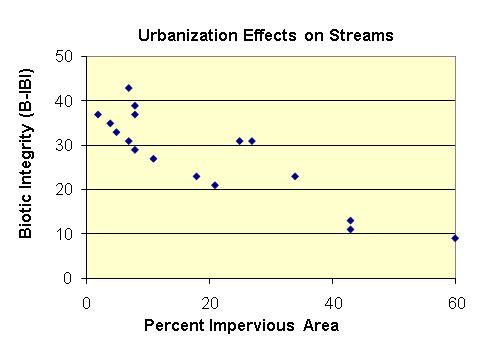Urbanization poses a major threat to stream and watershed ecosystems.
When we clear lands, remove wetlands, and pave roads, we increase
overland runoff and increase the severity of river siltation and scour.
By logging and removing vegetation close to streams, we alter stream
temperature and remove valuable streamside nutrients, leading to changes
in stream organism richness, health, and composition. The urban dust
we create, laden with poisonous heavy metals, drops continuously from
the sky. These are just a few of the factors that contribute to the
degradation of urban environments. In a study from the mid 1990's,
William J. Kleindl attempts to quantify the impact of urbanization
on the biological health of streams in the Puget Sound lowlands of
Washington State.
Kleindl uses percent impervious surface as a proxy for the amount
of urbanization. He examined aerial and satellite images of the sample
watersheds to estimate the areas or regions dedicated to different
types of land use. Each type of land use had a pre-assigned impervious
percentage. On the upper end of the scale, commercially developed
areas were designated 90% impervious; on the lower end, agricultural
and forest land were deemed 2% imperious. Land use area percentages,
weighted by their impervious percentages, were then summed to get
an overall watershed impervious percentage. Simple math, very effective.
In the study, macroinvertebrates were sampled at 31 sites in 18 different
streams during September 1994 to determine urbanization effects on
the streams' biotic integrity. Kleindl describes biotic or
biological integrity as, "the capability of supporting and maintaining
a balanced, integrated, adaptive community of organisms having a species
composition and functional organization comparable to that of natural
habitat in the region." The 18 streams represented a wide range
of land use conditions in rural, suburban and urban watersheds. Data
from 17 of the sites were used to create the Benthic Index of Biotic
Integrity (B-IBI) and are presented here; data from the remaining
14 sites were used to test the B-IBI, and can be found in the original
paper.
The sampled macroinvertebrates were tested for 9 attributes (metrics)
that were proven to be sensitive to urbanization effects. Of these
9 metrics, 7 measured invertebrate composition and richness (Average
Taxa Richness, Ephemeroptera Richness, Plecoptera Richness, Trichoptera
Richness, Intolerant Taxa Richness, Long-lived Taxa Richness). Community
structure was measured by 2 percentage metrics (Percent Planaria and
Amphipoda Abundance, and Percent Tolerant Taxa). The final percentage
metric (Percent Predator Richness) measured impact on feeding (trophic)
levels. For each of these 9 metrics, data from the 17 sites were ranked
in order from least impacted to most impacted. Streams that were least
impacted were given a score of 5, intermediate streams were given
a score of 3, and the most impacted streams were given a score of
1. (Assignments to categories were somewhat arbitrary.) The sum of
these 9 metric scores provided a total B-IBI score for each stream.
Students might use the data provided here to address the following
questions:
- Is percent impervious surface an overall good predictor of the
biological health of a stream?
- For which percentages does there seem to be more variability in
the data? How does this variability affect predictions for different
percentages of impervious surface?
- What factors might contribute to the variability mentioned above,
or is this simply random variability?
- Is there an equation whose graph fits the data well, and if so,
how can you measure the goodness of fit?
- At any point along a best fitting equation, what would the slope
measure?
- Which of the 9 individual metrics is most sensitive or intolerant
to urbanization?
- Why do some of the metrics increase, while others decrease, as
percent impervious surface increases?
- What are some other factors, besides impervious surface, that
would lead to the decline in biological integrity of a stream? Considering
your answer, is it fair to predict biological integrity using only
impervious surface?
- Is it better to spend money improving areas with low biologic
integrity or protecting areas with high biologic integrity?
Data source: Kleindl, William J. 1995. A Benthic Index of Biotic
Integrity for Puget Sound Lowland Streams, Washington, USA. Thesis
submitted for a Master of Science degree at the University of Washington in Seattle.
